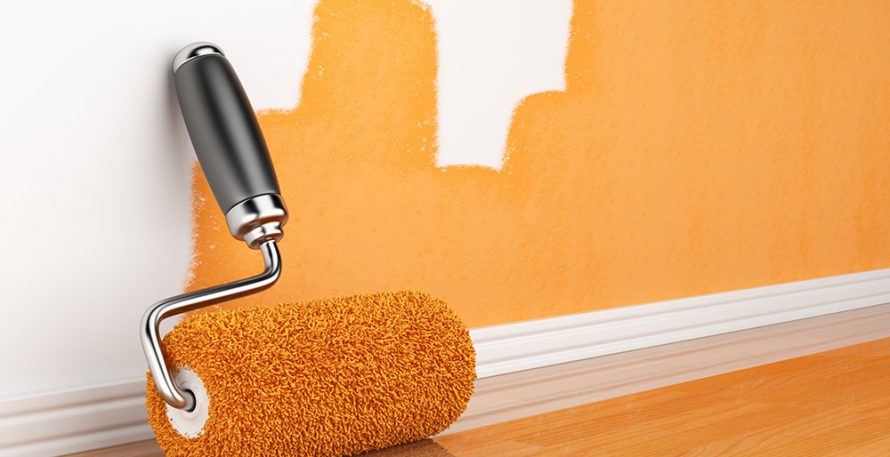Choosing the colours to use in your home can be a daunting task. Each paint company offers thousands of colours, and most are able to match their competitor’s colours. Few colours are unattainable with modern paint technology. Even metallics and true-blacks are possible, if not as robust or versatile as more conventional paints. This leaves consumers spoiled by near-unlimited choice. Add to this challenge the varying goals of each consumer, the appeal of current trends, and practical considerations of each space, and many people find themselves in need of a little help. As painters, we consider it our duty to our customers to cultivate a deep understanding of colour, so that we can help you narrow down this vast selection to those that you like and that work. That’s why we’ve identified…
The Three Challenges of Choosing a Colour
1. Trends
Trends come and go in a predictable pattern: They build in exposure and popularity, eventually spilling over into widespread acceptance and appreciation, before reaching a critical mass (normalcy) and imploding. In the years after their passing, they become the subject of ridicule, if anyone remembers them at all. For evidence of this phenomenon, please refer to your high school yearbook.
But as predictable as this pattern is, predicting when a trend will fall by the wayside isn’t. At a certain point in a trend’s life-cycle, it’s hard to tell it even is a trend, and not a new enduring norm. Also, worrying about the future of a trend isn’t a problem at all if you enjoy the trend in the moment. Most trends become as popular as they are because they’re actually good! 1988’s mullet may be ridiculous in retrospect, but how else could you dirty dance and throw high-kicks without getting long hair in your eyes? For evidence of this phenomenon, please refer to Patrick Swayze.
All of this is relevant to choosing paint colours. Colour trends often spread from clothing, to housewares, to paint. The colours you love in other places are a great source of inspiration. These days, you can hardly look at social media without encountering Millenial Pink. Similarly, Celadon has quietly staked its place in our present pallet. Both are lovely colours, and we would recommend either for accent walls or bathrooms. However, as trendy colours, they have a finite lifespan. And that makes them great choices right now. In ten years, these colours will have different associations, and you may not want your home to share the colour of a post-war hospital. That, of course, only means it’s time to draw new inspiration for new colours!
There are many reasons, though, to avoid colour trends entirely. You may have plans to sell your home. Maybe you don’t want to choose a colour that will clash with your furniture. Many people prefer a more minimal aesthetic. These are all great reasons to stay within the neutral range, with colours that match everything and are broadly inoffensive. Neutrals are safe and versatile, and choosing the right neutral is a question of broader, sweeping trends, and the practical challenges of the space.
In this century, builders pivoted away from using wood trim, forgoing the mahoganies, oaks, and maples of past decades in favour of cheaper MDF boards, made of compressed wood fibers and resin. Since MDF in its raw state is ugly, soft, and vulnerable to water infiltration, it’s necessary to paint it. Typically, MDF trim is painted white or off-white, which had the undesired effect of washing out rooms with white or off-white walls. In order to regain the contrast that was possible with darker wood trim and pale walls, designers flipped the script, and made walls darker. At first, they chose neutral, earthy tans that echoed the lost colour of wood. But in the 2010s, designers pushed towards using darker, more technical looking greys, which elevated the contrast possible in a paint job, while still satisfying the commercial need to keep wall colours neutral.
Grey made customers happy and became a safe choice, providing sharp looking paint jobs with broad appeal. Lately, designers have been returning to white wall paint, despite white trim, inspired by the aesthetics of northern European homes, which often don’t even use door and window trim. White walls make brilliantly bright spaces. They’re great for showcasing nice pieces of furniture or art. And designers have rediscovered its compatibility with wood, reintroducing wood accents on ledges and railings. In high-end construction, lush wood trim and timbers radiate deep, inimitable natural colour next to white walls. But white isn’t always white. The colour we perceive on an object is actually the spectrum of light that the object reflects, which happens to be our second challenge…
2. Light
White reflects the entire spectrum of light that touches it. This means that the colour you see is actually the colour of the room. This is great when the room is in direct sunlight or under the temperature of artificial light you prefer, since you see that light unfiltered. But indirect sunlight makes white rooms look dreary and cold, rendering white walls unsuitable for rooms with northern exposures. It can also mean that east facing rooms experience a limited window of brilliance in the morning before descending into gloom for the rest of the day. Fortunately, attaining a white room is possible in sub-optimal light conditions thanks to the miracle of off-white colours. By choosing a slightly yellow off-white, we can counteract the bluing effect of indirect light, giving the illusion of true-white. Benjamin Moore’s Antique Yellow, for example, shines golden in direct sunlight, and washes out to a tranquil white in indirect sun. In artificial light, it takes on a pleasing incandescent warmth, perfect for relaxed evenings.
The changing appearance of white paint in different lights is a function of colour temperature, with blues being “cool” and oranges being “warm”. When we know what the colour temperature of the light in a room tends to be, we can anticipate the light’s effect on colour–whether it will make the colour more blue or orange–and pick colours accordingly. With white paint reflecting the complete spectrum of light, it’s particularly subject to changing with the colour temperature of light. But it’s not the only paint colour that does so. In a room with a north-facing window, we can expect a full day of cool light. Should you not wish to use a white paint, we suggest two solutions.
The first is to accept that the room will have a cool colour, and embrace it. Cool light can’t change that which is already cold. The on-trend colour celadon, which we mentioned earlier in this article, would function in a cool-light room. It’s even possible to paradoxically achieve warmth from a cool colour, such as with this timeless shade of blue.
The second solution is to choose a colour that isn’t impacted by light. In the same way that white reflects the full spectrum of light, and therefore changes with the temperature of light, darker colours reflect the least light, and change the least with the colour temperature. This solution grants us two paths: one towards brighter colours and one towards darker neutrals.
Should you wish to paint in colour, brighter is better in indirect sunlight. While white reflects the full spectrum, and black reflects nothing, red reflects, predictably, red-spectrum light. A colour that does not reflect blue cannot be affected by blue light. In practice, this kind of absolute occlusion of a colour spectrum is impossible. But jewel tones and brilliant colours tend to stay true regardless of light temperature, making them ideal choices for north-facing rooms.
On the other hand, if you wish to stick to neutral tones, darker grey reflects less light, and allows less change with colour temperature. The colour linked above even incorporates a warm tone to offset any bluing that may occur. The obvious downside to choosing a darker grey is that it will darken the room. The prospect of further sacrificing light in north-facing rooms, which frequently lack light at the best of times, can make darker colours unsuitable.
That brings us to the other side of light’s role in paint colour: Brightness. Designers rate each paint colour with an LRV (light reflectance value) score, as a percentage of how much light it reflects, 100 being totally reflective and 0 being totally non-reflective. An LRV of at least 80 is desirable for rooms that you wish to brighten. Of course, not everyone wishes to brighten every room, and for certain purposes, brightness is inappropriate. Nailing down the practical requirements of the space, brings us to our third challenge.
3. Use of the room
What you plan to do in a room is vitally important to choosing a colour. To make an extreme example, we would never paint a darkroom (for developing photos) bright white. Because reducing the amount of light in a darkroom is so fundamental to its purpose it’s built into its name, we would choose a paint that reflects little light. While the existence of digital photography means it’s unlikely that you have a darkroom in your home, every room has a function, and keeping a mind towards that function can assist in paint colour selection. As with light’s effect on paint colour, we can consider colours on two axes: brightness and colour.
Brightness follows a clear linear relationship to space: lighter is more spacious, darker is more cozy. This has clear implications for colour selection depending on your room. Living rooms, family rooms, great rooms, and rec rooms typically benefit from space, and benefit from lighter colours. In contrast, a den or study is a close, intimate space and benefits from darker colours. Think of the smoking rooms of the past, characterized by dark woods and deep greens or reds.
Bedrooms offer challenges different from any other room. They’re the rooms where we sleep, an act that begs for darkness. But they’re also the rooms where we wake up every day, an act eased by light. They’re also our rooms, our private quarters, where we are free to express our personal tastes in a way we can’t in the more public parts of our homes. There’s significant evidence that warmer colours improve relaxation and somnolence in the evening. Reconciling the tensions between the competing needs and possibilities of a simple room is no simple task.
The literature on colour theory abounds with relationships between certain colours and certain moods and activities. Greens foster creativity. Reds stimulate the appetite. Yellows are uplifting. Blue is at once soothing and mentally stimulating–a plausible claim given colour temperature’s effect on our ability to sleep. All of this is worth considering with respect to the purpose of your room. You may not buy into the psychological effects of different colours, but if you find that you accomplish your best work in a green room, for example, your choice of colour for your office is obvious. And remember: if you absolutely can’t choose, red is supposed to inspire decisiveness!
We are also happy to provide a colour consult. Get in touch, and we’ll help you pick just the right colour.


